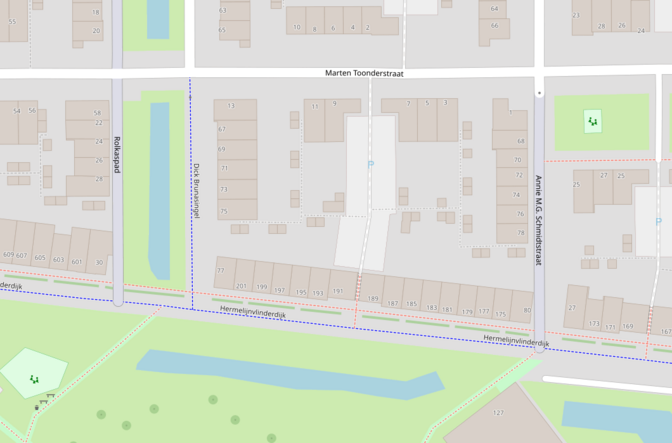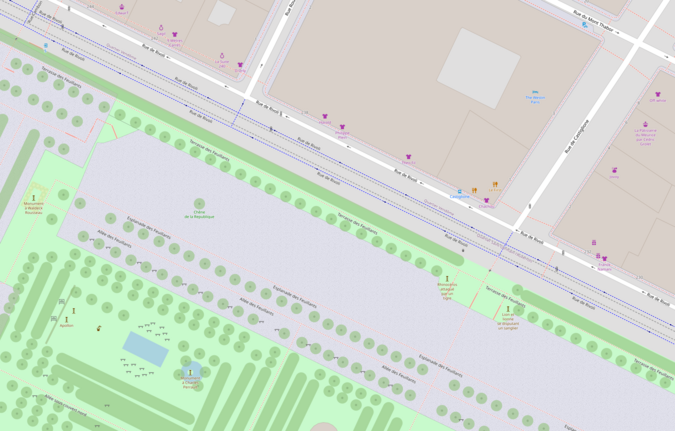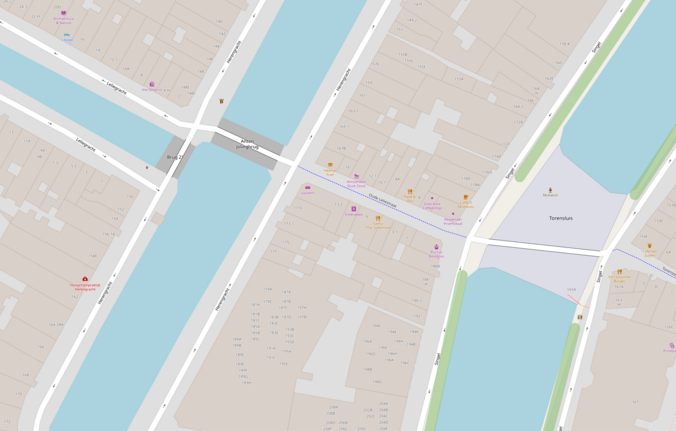User:Tjuro/Highway=cyclist
| Highway=cyclist | |
|---|---|
| Proposal status: | Draft (under way) |
| Proposed by: | Tjuro |
| Tagging: | highway=cyclist |
| Applies to: | |
| Definition: | Roads (almost) exclusively for cycle traffic. |
| Draft started: | 2024-01-03 |
Proposal
A highway=cyclist is a road or street mainly or exclusively for cycle traffic. Often found in the center of cities and inside residential neighborhoods. They can also be found as roads between cities or towns. They are either from roads that have been cycleized or are purpose built. Many but not all have buildings along them and would classify as a street. A highway=cyclist can best be described as a hybrid beween a highway=cycleway and a highway=residential.
Proposed is that:
highway=cyclist is approved with the definition:
Roads (almost) exclusively for cycle traffic.
Rationale
When it comes to pedestrian paths, roads, and streets we have a good distinction between paths and roads in the form of highway=footway versus highway=pedestrian. With cycle traffic we do not make the same distinction. All paths, roads and streets that are designated and exclusive for cycle traffic get tagged highway=cycleway. While bicycle=designated can be used in conjunction with any highway type, this does not reflect the described situation. To describe a street exclusively for cycle traffic many other access tags would need to be present, like motor_vehicle, moped, microcar and mofa.
Many people think as highway=cycleway as being paths. However there are cycleways that are roads. And we do not make any distiction between them. Because of the fact that there are streets that are also cycleways, there is no consensus on how these should be mapped. Many are mapped `highway=cycleway` however some argue that these should be mapped `highway=residential+access`.
This leads to some problems:
First, without any differentiation factors it is currently impossible to render roads differently from paths. Let’s say you want to only show roads, then you render highway=residential/unclassified and highway=cycleway however not all highway=cycleway are roads, Many are paths so then you are rendering a lot of paths as roads. And vice versa.
Secondly, the described situation is tagged inconsistently around the word. In the Netherlands it is currently unacceptable to tag cycleways as anything but highway=cycleway. So all roads, streets and paths will be highway=cycleway. However, in other countries highway=redidential + access tags are used to describe similar situations. Another schema is highway=cycleway+cycleway=on_street.
Tagging
To clarify to which level each indicator should be present they will be structured with the MoSCoW method.
Must have:
- A roadway which exclusively allows cycle traffic.
- Signs indicating that it is exclusively meant for cycle traffic.
- A signed name.
- A wide enough roadway for four-wheeled (emergency) vehicles.
Should have:
- Buildings build along it.
- Addresses with the same name.
- Sidewalks.
- Kerbs.
- Lighting.
- Drainage.
- Access for emergency vehicles.
Could have:
- Priority over crossing vehicular roads.
- Bollards.
- Manhole covers.
Won't have:
- Vehicular traffic.
- Parking for vehicular vehicles.
- Parallel roads for vehicular traffic.
Common examples of where these indicators can be found are:
- Roads or streets that have been cycleized.
- Purpose built cyclist streets.
While a highway=cyclist is wide enough for one-way vehicular traffic, bollards are generally not present, this is to allow for emergency vehicles and incidental service vehicles to enter. These include:
- Police, fire, and ambulance.
- Snow clearing, leaf clearing.
- Utility services like repairing streetlights and sewer maintenance.
All these vehicular uses are strictly incidental. Recurring uses depend on the signage, some highway=cyclist allow for delivery and loading and unloading at specific times. However, any unrestricted vehicular usage, even with behavioral instructions like living_street cyclestreet and bicycle road, invalidate a road from being a highway=cyclist.
Examples
Hermelijnvlinderdijk, Utrecht, the Netherlands
In this area the Marten Toonderstraat is the mixed-use street, and Hermelijnvlinderdijk is the cyclist road going through the whole neighborhood. Connecting the two are pedestrian streets and a cyclist street named Dick Brunasingel. All off the addresses are tied to the cyclist roads.
https://www.openstreetmap.org/#map=19/52.09586/5.05143
Rue de Rivoli, Paris, France
This street has recently been cycleized, some vehicular traffic is still allowed on the highway=service sidepath. However, this still counts as a highway=cyclist.
https://www.openstreetmap.org/#map=18/48.86521/2.32747
Oude Leliestraat, Amsterdam, the Netherlands
Another example of a street that has been cycleized. This one is too narrow for vehicular traffic, however because its role in the cycle network it has not been pedestrianized.
https://www.openstreetmap.org/#map=19/52.37464/4.88876
Rendering
FAQ
Why “cyclist” as value?
The value “cyclist” has been chosen to keep similarity to highway=footway/pedestrian.
| Street type | Path | Road/Street |
|---|---|---|
| A pedestrian street | footway | pedestrian |
| A cyclist street | cycleway | cyclist |
Other values like highway=cycle_road, highway=bicycle_road and highway=cycle_street have been considered; however, a cyclestreet is commonly referred to a street where vehicular traffic can go, and a bicycle road is a similar but slightly different from a cyclestreet. Both of these are tagged as sub tags with cyclestreet=yes and bicycle_road=yes respectively.
These values are discarded because they would cause too much confusion with existing tagging. Especially because these other schemas allow for vehicular traffic and highway=cyclist does not.
What is the difference between a bicycle road (bicycle_road=yes) and a street that is exclusively for cyclists?
bicycle_road=yes describes a legal concept and not a specific highway classification. While some bicycle_road=yes are also highway=cyclist. Some bicycle_road=yes allow for vehicular traffic disqualifying them from being a highway=cyclist. Furthermore, because bicycle_road=yes describes a legal concept. In some countries it might not be present at all. While highway=cyclist describes a situation which could occur in any country.
What is the difference between a cyclestreet/bicycle road and a street that is exclusively for cyclists?
A cyclestreet (cyclestreet=yes) is a street or road that has vehicular (local) traffic. But that has tweaks added to that street or road to make it more friendly cycle traffic. A cyclestreet can also have vehicular vehicle parking. On the other hand, a street or road that is exclusively for cyclists does not have any vehicular traffic and should not have vehicular vehicle parking.
What is the difference between a highway=cycleway and a highway=cyclist?
While both highway=cycleway highway=cyclist are highways that are exclusive for cycle traffic the main differentiator is that highway=cycleway are paths and highway=cyclist are roads. What exactly is a road, and a path depends on the local area. However, the indicators from “How to recognize a highway=cyclist?” give a good indication.
Why not make this a separate sub tag to distinguish this instead of having a new highway type?
This new highway types distinguishes between paths and roads. Creating a separate tag to accomplish the same goal has complications for highway=footway/pedestrian. Since that new tag would invalidate all highway=pedestrian, and effectively make them highway=footway + that new tag.
Are all separated cycleways now cyclist roads?
While some objects that are currently tagged as highway=cycleway should instead be highway=cycleway not all of these qualify as a road. A path can be a separated object, common examples are cycleways in nature areas.
What is cycle traffic?
All traffic under highway=* can be categorized in three main categories:
- Pedestrian traffic
Pedestrian traffic are people on foot including slower mobility scooters, wheelchairs. Generally, they go slower than 15kmh and are not considered drivers.
- Vehicular Traffic
Vehicular traffic refers to the movement of various types of vehicles on roads and highways. This category includes automobiles, motorcycles, trucks, buses, and any other motorized vehicles. Vehicular traffic is characterized faster speeds than pedestrian and cycle traffic. Vehicular vehicles do not use own power and need license and registration.
- Cycle traffic
Cycle traffic is a hybrid of these two, having characteristics of both. It refers to people on bicycles, microcars, faster mobility scooters, mopeds, mofas and other forms of micro mobility. The speed is generally higher than pedestrian traffic but slower than vehicular traffic. Some of the cycle traffic require own input of power. A speed restriction is required for a vehicle to be considered cycle traffic. For many forms of cycle traffic licence and registration is not required, however unlike pedestrian cycle traffic users are considered drivers, and therefore have to obey to other rules than pedestrians.
Features/Pages affected
External discussions
Comments
Please do not comment.


